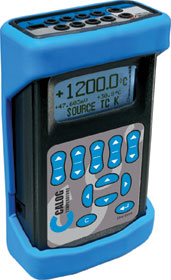

Many primary measurements in process plants are analog in nature and only become digital after processing. Temperature often starts out as voltage derived from a thermocouple or from a charge in resistance from metals like platinum, nickel or semiconductors or measured infrared radiation. Pressure, flow and force are measured by physical deformation of strain gauges. This means that in plant maintenance, commissioning and instrumentation workshops, process calibrators remain indispensable.
Since most field transmissions have error limits of less than 0,5%, calibration equipment needs to be an order of one magnitude higher (0,05%). Modern single chip voltage references, 24 bit serial A/Ds and 20 bit D/As can be within full-scale limits of 0,01%. The trick is to design input circuits with low-drift amplifiers for voltage and high stability shunts for current and resistance, for minimum additional error.
Where a precision instrument like a process calibrator is going to be used in the field, it must be rugged, both physically and electrically, and have an acceptable battery life. Besides the normal CE requirements, for electrical emission and noise immunity, inputs need additional surge protection via heavy duty MOVs and high-speed fuses.
Instrotech’s Calog range
Instrotech’s locally designed and manufactured Calog range of portable process control calibrators incorporate the modern component technology, comprehensive feature capabilities and tough package design, making the units ideal for use in servicing, repairs in workshops and in tough plant environments.
The handheld Calog-Temp multifunctional temperature calibrator is a high-precision instrument for the calibration and troubleshooting of process control instrumentation. It has selectable automatic, manual or internal cold junction compensation. Temperature can be displayed digitally or in the form of a trend, ideal for monitoring temperature over time or optimising PID controllers. Inputs and outputs are isolated from each other and can be displayed simultaneously making this unit ideal for measuring temperature or calibrating 2, 3 or 4-wire transmitters. The mA output can be set to track the temperature for use as a transmitter replacement in emergencies.
In RTD mode the calibrator is suitable for 2, 3 or 4-wire measurement or sourcing of platinum and nickel RTDs as well as ohms and mA. RTD, ohms and mA can be measured or sourced and as they are isolated from each other, and can be displayed simultaneously making this unit ideal for measuring temperature or calibrating RTD transmitters. Data-logging (SD card) and downloading via the on-board USB port is standard. It measures mA, mV, thermocouple, ohm and resistance temperature detector (RTD) in a single device. It simultaneously measures and sources ten commonly used types of thermocouples (K,J,T,B,R,S,E,N,U,L) and seven (Pt50, Pt100, Pt200, Pt500, Pt1000, Ni100 and Ni120) resistance temperature detectors (RTD). It measures mA (passive or active) with a 24 V power supply whilst sourcing or simulating mV, TCs, RTDs or ohms to calibrate transmitters. The thermocouple ranges have automatic internal cold junction or manual or external temperature compensation. The temperature ranges are isolated from the mA and can be displayed simultaneously. Injecting thermocouple mV (or RTD ohms) into a transmitter while measuring the output (mA) simplifies field or workshop calibration.
A plug-in extender is supplied with spring terminals for bare wire connection directly to thermocouple wires or compensating cables. The cold junction correction is built into this unit. The backlit LCD display can be selected for measurement in a clear, precise numeric display or as a graph for use when logging temperature or mA over longer periods. This is ideal for when monitoring ovens or optimising PID control.
For more information contact Hugh du Plessis, Instrotech, +27 (0)11 462 1920, [email protected], www.instrotech.co.za
| Tel: | +27 10 595 1831 |
| Email: | [email protected] |
| www: | www.instrotech.co.za |
| Articles: | More information and articles about Instrotech |
© Technews Publishing (Pty) Ltd | All Rights Reserved